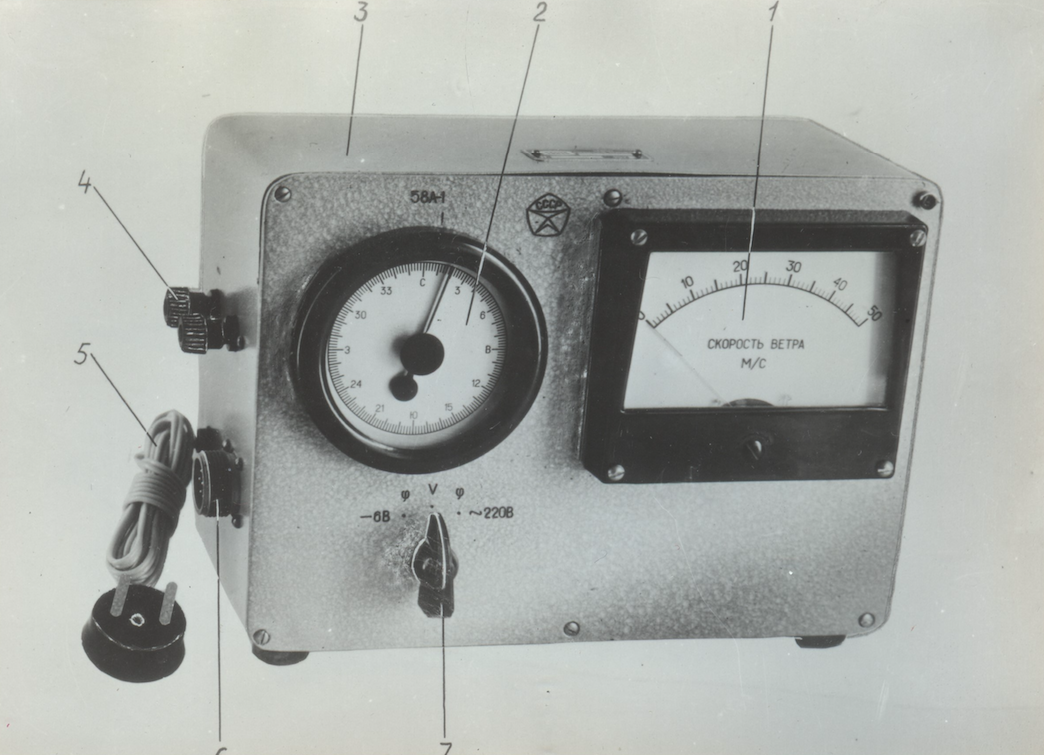Written by Marek Kaiper
The wind gauges ARME-1M, M-47 i M-63M-1.
Wind gauge, the name anemometer is also used, in older publications you can find the name rumboanemometer, which is an exact tracing paper from the Russian language. This name refers to anemometers that measure two parameters, wind speed and direction, which makes it more precise. A good Polish name is the speed-direction anemometer. In turn, anemometers measuring 4 parameters, i.e. wind speed and direction as well as temperature and relative humidity are called meteorological stations for remote measurements (M-49 measures wind speed, wind direction, air humidity and temperature, M-49M also measures atmospheric pressure, ship pressure DMS-N-53 and GM-6 (with a Soleyron wheel to measure the wind direction) additionally measure the water temperature). Anemometers of various types are used mainly in air forces, civil communication and sports airports, navy (port and ship), barrel and rocket artillery, chemical forces, meteorological service, sports (sailing, ski jumping) as well as in the construction of skyscrapers, high cranes and wind farms. No flights can take place in aviation without anemometers. During the Polish People’s Republic and a few years after it, anemometers made by the USSR were used in the military aviation, the main representative of which was the M-47, it replaced the older ARME-1M model. In turn, the M-47 was replaced in the 1980s by the M-63M-1 anemometer. Moreover, manual anemometers with the ARI-49 bowl rotor were used in the Polish Air Force. In the USSR / Russia, many types of anemometers were used (ARI-49, M-25, ARME-1, M-47, M-49, M-63, M-63M, M-63M-1, M-92, GM -6, DMS-N-53, KIW-1, KIW-2 (Korabielnyj Izmieritel Wietra), M-12, M-63MP, M-64 anemorumbographs with data recording and others. impulse anemometers on reed switches N-184, N-185, N-188 and OLKO Zakład Montaż Urządzeń Elektronicznych N-188 C, N-188D, N-188D + However, their measuring range was lower than that of Russian anemometers, it was 0-30 m / sec and in the nautical version N-185 0-40 m / sec and additionally in the Beaufort scale 0 ° -12 ° B, wind direction 0 ° -360 ° (it was the only Meratronik anemometer with wind direction measurement). The N-188 anemometers were equipped with signaling system for two wind speeds selected in the range of 0-30 m / sec. They could also switch electrical systems on or off by means of relays after exceeding the set wind speed. Manufactured by OLKO Zakład Mont For Electronic Devices, the N-188D + anaemometer is equipped with a digital wind speed indicator in the range of 2-30 m / sec. The measurement result can also be displayed in km / h. Wind direction measurement is shown on the indicator with LED diodes in the rumble system (32 divisions spaced at 11.25 °).
By design, anemometers are divided into mechanical and electrical. The latter, depending on the method of transforming the wind force into voltage, are divided into: inductive (tachometric generator) and impulse. They include mechanical (contacts closed with an appropriate cam), reed switches closed with a magnet or Hall sensors responding to a magnetic field. The wind speed measuring device is driven by multi-blade propeller rotors or cup carousel rotors with a vertical axis of rotation. To determine the wind direction, potentiometric sensors of the angle of rotation, selsins, resolvers (rotary transformer) or impulse systems are used. Nowadays, the latest devices for measuring wind parameters are ultrasonic anemometers and ultrasonic atmospheric probing devices (sodar).
Written by Marek Kaiper

